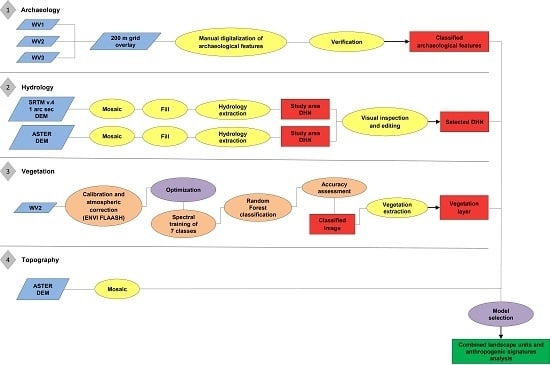High and Medium Resolution Satellite Imagery to Evaluate Late Holocene Human–Environment Interactions in Arid Lands: A Case Study from the Central Sahara
Abstract
:1. Introduction
The Central Sahara: Archaeology, Environment, and Remote Sensing
2. Materials and Methods
2.1. Study Area
2.2. Imagery Data
2.2.1. SRTM and ASTER DEM
2.2.2. Worldview 1–3
2.3. Delineation of Surface and Near-Surface Drainage Networks
2.4. Land Cover
2.4.1. Defining Land Cover Classes and Reference Data Collection
2.4.2. Random Forest (RF) Classifier
2.4.3. Accuracy Assessment
2.5. Anthropogenic Signatures in the Landscape
2.6. Statistical Analysis
3. Results
3.1. Hydrological Network
3.2. Land Cover Classification for the Extraction of Vegetation
3.2.1. Random Forest Parameters Setting
3.2.2. Vegetation and Other LULC Classification
3.2.3. Accuracy Assessment
3.3. Anthropogenic Features
3.4. Point Process Models
4. Discussion
5. Conclusions
Acknowledgments
Author Contributions
Conflicts of Interest
Abbreviations
| RS | Remote Sensing |
| GIS | Geographic Information Systems |
| LULC | Land Use Land Cover |
| NDVI | Normalized Difference Vegetation Index |
| MLC | Maximum Likelihood Classifiers |
| RF | Random Forest |
| DEM | Digital Elevation Model |
| CART | Classification and Regression Trees |
References
- Biagetti, S.; Cancellieri, E.; Cremaschi, M.; Gauthier, C.; Gauthier, Y.; Gallinaro, M.; Zerboni, A.; Di Lernia, S. The “Messak Project”: Archaeology and heritage management in SW Libya. J. Afr. Archaeol. 2013, 11, 55–74. [Google Scholar] [CrossRef]
- Cosentino, L. Hydrocarbon exploration and production and cultural heritage: Eni’s persepective. In Edeyen of Murzuq. Archaeological Survey in the Libyan Sahara; Anag, G., Cosentino, L., di Lernia, S., Eds.; Insegna del Giglio: Firenze, Italy, 2013; pp. 17–20. [Google Scholar]
- Duncan, C.; Kretz, D.; Wegmann, M.; Rabeil, T.; Pettorelli, N. Oil in the Sahara: Mapping Anthropogenic Threats to Saharan Biodiversity from Space. Phil. Trans. R. Soc. B 2014, 369. [Google Scholar] [CrossRef] [PubMed]
- Mattingly, D.J.; Sterry, M. The first towns in the central Sahara. Antiquity 2013, 87, 503–518. [Google Scholar] [CrossRef]
- Merlo, S.; Hakenbeck, S.E.; Balbo, A.L. Desert Migrations Project XVIII: The archaeology of the northern Fazzan. A preliminary report. Libyan Stud. 2014, 44, 141–162. [Google Scholar] [CrossRef]
- Di Lernia, S.; Gallinaro, M. Libya before and after the conflict: What future for its cultural heritage? In Archaeological Dimension of World Hertiage; Castillo, A., Ed.; Springer: Now York, NY, USA, 2014; pp. 73–87. [Google Scholar]
- Agapiou, A.; Lysandrou, V. Remote sensing archaeology: Tracking and mapping evolution in European scientific literature from 1999 to 2015. J. Archaeol. Sci. Rep. 2015, 4, 192–200. [Google Scholar] [CrossRef]
- Lasaponara, R.; Masini, N. Satellite remote sensing in archaeology: Past, present and future perspectives. J. Archaeol. Sci. 2011, 38, 1995–2002. [Google Scholar] [CrossRef]
- Biagetti, S.; di Lernia, S. Combining intensive field survey and digital technologies: New data on the Garamantian castles of wadi Awiss, Acacus mts., Libyan Sahara. J. Archaeol. Sci. 2008, 6, 57–85. [Google Scholar] [CrossRef]
- Cremaschi, M.; di Lernia, S. The geoarchaeological survey in the central Tadrart Acacus and surroundings (Libyan Sahara). Environment and cultures. In Wadi Teshuinat. Palaeoenvironment and Prehistory in South-Western Fezzan (Libyan Sahara); Cremaschi, M., di Lernia, S., Eds.; CNR: Milano, Itlay, 1998; pp. 243–325. [Google Scholar]
- Gallinaro, M. Saharan rock art: local dynamics and wider perspectives. Arts 2013, 2, 350–382. [Google Scholar] [CrossRef]
- Biagetti, S.; Ait Kaci, A.; Mori, L.; di Lernia, S. Writing the desert. The ‘Tifinagh’ rock inscriptions of the Tadrart Acacus (south-west Libya). Azania 2012, 47, 153–174. [Google Scholar] [CrossRef]
- Biagetti, S.; Ait Kaci, A.; di Lernia, S. The ‘written landscape’ of the central Sahara: Recording and digitizing the Tifinagh inscriptions in the Tadrart Acacus Mountains. In From Dust to Digital. Ten Years of the Endangered Archives Programme; Kominko, M., Ed.; Open Book Publishers: Cambridge, UK, 2015. [Google Scholar]
- Camps, G. Aux Origines de la Berbérie. Monuments et Rites Funéraires Protohistoriques; Arts et Métiers Graphiques: Paris, France, 1961. [Google Scholar]
- Mattingly, D. Religious and funerary structures. In The Archaeology of Fazzan: Volume 1. Synthesis; Society for Libyan Studies: London, UK, 2003; pp. 177–234. [Google Scholar]
- Milburn, M. Saharan stone monuments, rock picture and artefact contemporaneity: Some suggestions. Memorie della Societa Italiana di Science Naturali e del Museo Civico di Storia Naturale di Milano 1993, 26, 363–374. [Google Scholar]
- Pace, B.; Sergi, S.; Caputo, G. Scavi Sahariani: Ricerche nell’Uadi el-Agial e nell’Oasi di Gat; Academia Nazionale dei Lincei: Rome, Italy, 1951. [Google Scholar]
- Reygasse, M. Monuments Funéraires Préislamiques; Arts et Métiers Graphiques: Paris, France, 1950. [Google Scholar]
- Di Lernia, S.; Manzi, G. Sand, Stones and Bones: The Archaeology of Death in the Wadi Tannezzuft Valley (5000–2000 BP); All’Insegna del Giglio: Firenze, Italy, 2002. [Google Scholar]
- Edwards, D.N. The archaeology of Southern Fazzan and prospects for future research. Libyan Stud. 2001, 32, 49–66. [Google Scholar] [CrossRef]
- Mattingly, D.J. The Archaeology of Fazzan; Society for Libyan Studies: London, UK, 2003. [Google Scholar]
- Mori, L. Fortified citadels and castles in Southern Fazzan (Libyan Sahara) in Garamantian times. In The Power of Walls. Fortifications in Ancient Northeastern Africa; Jesse, F., Vogel, C., Eds.; Heinrich-Barth-Institute: Köln, Germany, 2013. [Google Scholar]
- Liverani, M. The trans-Saharan caravan trade. In Aghram Nadharif: The Barkat Oasis (Shabiya of Ghat, Libyan Sahara) in Garamantian Times; Liverani, M., Ed.; All’Insegna del Giglio: Firenze, Italy, 2005. [Google Scholar]
- Nixon, S. Excavating Essouk-Tadmakka (Mali): New archaeological investigations of early Islamic trans-Saharan trade. Azania Archaeol. Res. Afr. 2009, 44, 217–255. [Google Scholar] [CrossRef]
- Bewley, R.; Wilson, A.; Kennedy, D.; Mattingly, D.J.; Banks, R.; Bishop, M.; Bradbury, J.; Cunliff, E.; Fradley, M.; Jennings, R.; et al. Endangered Archaeology in the Middle East and North Africa: introducing the EAMENA Project. In Proceedings of the 43rd Annual Conference on Computer Applications and Quantitative Methods in Archaeology: Keep the Revolution Going, Oxford, UK, 30 March–3 April 2015. [Google Scholar]
- Cremaschi, M.; Zerboni, A. Early to Middle Holocene landscape exploitation in a drying environment: Two case studies compared from the central Sahara (SW Fezzan, Libya). C. R. Geosci. 2009, 341, 689–702. [Google Scholar] [CrossRef]
- Drake, N.A.; Blench, R.M.; Armitage, S.J.; Bristow, C.S.; White, K.H. Ancient watercourses and biogeography of the Sahara explain the peopling of the desert. Proc. Nati. Acad. Sci. USA 2011, 108, 458–462. [Google Scholar] [CrossRef] [PubMed]
- Breeze, P.S.; Drake, N.A.; Groucutt, H.S.; Parton, A.; Jennings, R.P.; White, T.S.; Clark-Balzan, L.; Shipton, C.; Scerri, E.M.L.; Stimpson, C.M.; et al. Remote sensing and GIS techniques for reconstructing Arabian palaeohydrology and identifying archaeological sites. Quat. Int. 2015, 382, 98–119. [Google Scholar] [CrossRef]
- Biagetti, S. Ethnoarchaeology of the Kel Tadrart Tuareg. Pastoralism and Resilience in Central Sahara; Springer International Publishing: Gewerbestrasse, Switzerland, 2014. [Google Scholar]
- Lehner, B.; Verdin, K.; Jarvis, A. New Global Hydrography Derived From Spaceborne Elevation Data. Eos Trans. Am. Geophys. Union 2008, 89, 93–94. [Google Scholar] [CrossRef]
- Cremaschi, M.; Pelfini, M.; Santilli, M. Cupressus dupreziana: A dendroclimatic record for the middle-late Holocene in the central Sahara. Holocene 2006, 16, 293–303. [Google Scholar] [CrossRef]
- Mercuri, A.M. Human influence, plant landscape evolution and climate inferences from the archaeobotanical records of the Wadi Teshuinat area (Libyan Sahara). J. Arid Environ. 2008, 72, 1950–1967. [Google Scholar] [CrossRef]
- Mercuri, A.M. Plant exploitation and ethnopalynological evidence from the Wadi Teshuinat area (Tadrart Acacus, Libyan Sahara). J. Archaeol. Sci. 2008, 35, 1619–1642. [Google Scholar] [CrossRef]
- Xie, Y.; Sha, Z.; Yu, M. Remote sensing imagery in vegetation mapping: A review. J. Plant Ecol. 2008, 1, 9–23. [Google Scholar] [CrossRef]
- Tucker, C.J. Red and photographic infrared linear combinations for monitoring vegetation. Remote Sens. Environ. 1979, 8, 127–150. [Google Scholar] [CrossRef]
- Koide, K.; Koike, K. Applying vegetation indices to detect high water table zones in humid warm-temperate regions using satellite remote sensing. Int. J. Appl. Earth Obs. Geoinf. 2012, 19, 88–103. [Google Scholar] [CrossRef]
- Birtwistle, A.N.; Laituri, M.; Bledsoe, B.; Friedman, J.M. Using NDVI to measure precipitation in semi-arid landscapes. J. Arid Environ. 2016, 131, 15–24. [Google Scholar] [CrossRef]
- Pohl, C.; van Genderen, J. Remote Sensing Image Fusion. A Practical Guide; CRC Press: Boca Raton, FL, USA, 2016. [Google Scholar]
- Pal, M. Advanced algorithms for land use and cover classification. In Advances in Mapping for Remote Sensor Imagery; Yang, X., Li, J., Eds.; CRC Press: Boca Raton, FL, USA, 2012. [Google Scholar]
- Otukei, J.R.; Blaschke, T. Land cover change assessment using decions trees, support vector machines and maximum likelihood classification algorithms. Int. J. Appl. Earth Obs. Geoinf. 2010, 12, 627–631. [Google Scholar] [CrossRef]
- Richards, J.A. Remote Sensing Digital Image Analysis: An Introduction, 4th ed.; Springer: Berlin/Heidelberg, Germany, 2005. [Google Scholar]
- Dubieuf, J. L’Ajjer, Sahara Central; Karthala: Paris, France, 1996. [Google Scholar]
- Hachid, M. Les premiers Berbères: Entre Méditerranée, Tassili et Nil; Ina-Yas, Edisud: Alger, Algeria, 2001. [Google Scholar]
- Lhote, H. The Search for the Tassili Frescoes: The Story of the Prehistoric Rock-Paintings of the Sahara; Dutton: New York, NY, USA, 1959. [Google Scholar]
- Leschi, L. La Mission scientifique du Fezzàn. Archéologie. Travaux de l’Institut de Recherches Sahariennes 1945, 3, 183–186. [Google Scholar]
- Gauthier, Y. Nouvelles réflexions sur les aires de distribution au Sahara central. Les Cahiers De L’AARS 2009, 13, 121–134. [Google Scholar]
- United States Geological Survey (USGS). Available online: https://lta.cr.usgs.gov/SRTM1Arc (accessed on 31 January 2017).
- Fujisada, H.; Urai, M.; Iwasaki, I. Technical methodology for ASTER Global DEM. IEEE Trans. Geosci. Remote Sens. 2012, 50, 3725–3736. [Google Scholar] [CrossRef]
- National Aeronautics and Space Administration (NASA). The Shuttle Radar Topography Mission (SRTM) Collection, Version 3. Available online: https://lpdaac.usgs.gov/sites/default/files/public/measures/docs/NASA_SRTM_V3.pdf (accessed on 31 January 2017).
- Cooley, T.; Anderson, G.P.; Felde, G.W.; Hoke, M.L.; Ratkowski, A.J.; Chetwynd, J.H.; Gardner, J.A.; Adler-Golden, S.M.; Matthew, M.W.; Berk, A.; et al. FLAASH, a MODTRAN4-based atmospheric correction algorithm, its application and validation. In Proceedings of the IEEE International Geoscience and Remote Sensing Symposium, Toronto, ON, Canada, 24–28 June 2002. [Google Scholar]
- Adler-Golden, S.M.; Matthew, M.W.; Bernstein, L.S.; Levine, R.Y.; Berk, A.; Richtsmeier, S.C.; Acharya, P.K.; Anderson, G.P.; Felde, G.; Gardner, J.; et al. Atmospheric correction for short-wave spectral imagery based on MODTRAN4. In Proceedings of the SPIE Imaging Spectrometry V, Denver, CO, USA, 18 July 1999. [Google Scholar]
- Jenson, S.K.; Dominque, J.O. Extracting topographic structure from digital elevation data for geographical information system analysis. Photogramm. Eng. Remote Sens. 1988, 54, 1593–1600. [Google Scholar]
- Reuter, H.I.; Hengl, T.; Gessler, P.; Soille, P. Preparation of DEMs for Geomorphometric Analysis. In Geomorphometry: Concepts, Software, Applications; Hengl, T., Reuter, H.I., Eds.; Elsevier: Amsterdam, The Netherlands, 2008. [Google Scholar]
- Congalton, R.G.; Green, K. Assessing the Accuracy of Remotely Sensed Data: Principles and Practices, 2nd ed.; CRC Press: Boca Raton, FL, USA, 2009. [Google Scholar]
- Olshen, L.; Stone, C.J. Classification and Regression Trees; CRC Press: Boca Raton, FL, USA, 1984. [Google Scholar]
- Breiman, L. Random Forests. Mach. Learn. 2001, 45, 5–32. [Google Scholar] [CrossRef]
- Lin, X.; Sun, L.; Li, Y.; Guo, Z.; Li, Y.; Zhong, K.; Wang, Q.; Lu, X.; Yang, Y.; Xu, G. A random forest of combined features in the classification of cut tobacco based on gas chromatography fingerprinting. Talanta 2010, 82, 1571–1575. [Google Scholar] [CrossRef] [PubMed]
- Genuer, R.; Poggi, J.-M.; Tuleau-Malot, C. Variable selection using random forests. Pattern Recognit. Lett. 2010, 31, 2225–2236. [Google Scholar] [CrossRef]
- Mutanga, O.; Adam, E.; Cho, M.A. High density biomass estimation for wetland vegetation using WorldView-2 imagery and random forest regression algorithm. Int. J. Appl. Earth Obs. Geoinf. 2012, 18, 399–406. [Google Scholar] [CrossRef]
- Team, R.C. R: A Language and Environment for Statistical Computing; R Foundation for Statistical Computing: Vienna, Austria, 2016. [Google Scholar]
- Crema, E.R.; Bianchi, E. Looking for patterns in the noise: Non-site spatial-analysis in Sebkha Kelbia. In Le Capsien de Hergla (Tunisie). Culture, Environnement et Économie; Mulazzani, S., Ed.; Africa Magna: Frankfurt, Germany, 2013. [Google Scholar]
- Dunnell, R.C. The notion site. In Space, Time, and Archaeological Landscapes; Rossignol, J., Wandsnider, L.A., Eds.; Springer: New York, NY, USA, 1992. [Google Scholar]
- Foley, R. Off-Site Archaeology and Human Adaptation in Eastern Africa; BAR Publishing: Oxford, UK, 1981. [Google Scholar]
- Mattingly, D.J.; Lahr, M.; Armitage, S.; Barton, H.; Dore, J.; Drake, N.A.; Foley, R.; Merlo, S.; Salem, M.; Stock, J.; et al. Desert Migrations: People, environment and culture in the Libyan Sahara. Libyan Stud. 2007, 38, 115–156. [Google Scholar] [CrossRef]
- Merlo, S.; Hakenbeck, S.E.; Balbo, A. DMP IV: 2008 fieldwork on historic settlement in the Wadi ash-Shati and the Dawada lake villages. Libyan Stud. 2008, 39, 295–298. [Google Scholar] [CrossRef]
- Berkani, H.; Zazzo, A.; Paris, F. Les tumulus à couloir et enclos de la Tassili du Fadnoun, Tassili Azger (Algérie): Premières datations par la méthode du radiocarbone. J. Afr. Archaeol. 2015, 13, 59–70. [Google Scholar] [CrossRef]
- Baddeley, A.; Turner, R.; Møller, J.; Hazelton, M. Residual analysis for spatial point processes (with discussion). J. R. Stat. Soc. Ser. B 2005, 67, 617–666. [Google Scholar] [CrossRef]
- McFadden, D. Quantitative methods for analyzing travel behaviour of individuals: Some recent developments. In Behavioural Travel Modelling; Stopher, P.R., David, A.H., Eds.; Croom Helm: New York, NY, USA, 1978. [Google Scholar]
- Karlson, M.; Ostwald, M. Remote sensing of vegetation in the Sudano-Sahelian zone: A literature review from 1975 to 2014. J. Arid Environ. 2016, 124, 257–269. [Google Scholar] [CrossRef]
- Castelli, R.; Gatto, M.C.; Cremaschi, M.; Liverani, M.; Mori, L. A preliminary report of excavations in Fewet, Libyan Sahara. J. Afr. Archaeol. 2005, 3, 69–102. [Google Scholar] [CrossRef]
- Di Lernia, S.; Tafuri, M.A. Persistent deathplaces and mobile landmarks. The Holocene mortuary and isotopic record from Wadi Takarkori (SW Libya). J. Anthropol. Archaeol. 2013, 32, 1–15. [Google Scholar] [CrossRef]
- Bevan, A.; Crema, E.; Li, X.; Palmisano, A. Intensities, interactions and uncertainties: Some new approaches to archaeological distributions. In Computational Approaches to Archaeological Spaces; Bevan, A., Lake, M., Eds.; Left Coast Press: Walnut Creek, CA, USA, 2013. [Google Scholar]
- Fortin, M.-J.; Dale, M.R.T. Spatial Analysis: A Guide for Ecologists; Cambridge University Press: Cambridge, UK, 2005. [Google Scholar]
- Eve, S.; Crema, E.R. A House with a View? Multi-model inference, visibility fields, and point process analysis of a Bronze Age settlement on Leskernick Hill (Cornwall, UK). J. Archaeol. Sci. 2014, 43, 267–277. [Google Scholar] [CrossRef]
- Blaschke, T.; Lang, S.; Lorup, E.; Strobl, J.; Zeil, P. Object-oriented image processing in an integrated GIS/remote sensing environment and perspectives for environmental applications. Environ. Inf. Plan. Politics Public 2000, 2, 555–570. [Google Scholar]
- Gao, Y.; Mas, J.F. A comparison of the performance of pixel-based and object-based classifications over images with various spatial resolutions. J. Earth Sci. 2008, 2, 27–35. [Google Scholar]
- Lobo, A. Image segmentation and discriminant analysis for the identification of land cover units in ecology. IEEE Trans. Geosci. Remote Sens. 1997, 35, 1136–1145. [Google Scholar] [CrossRef]
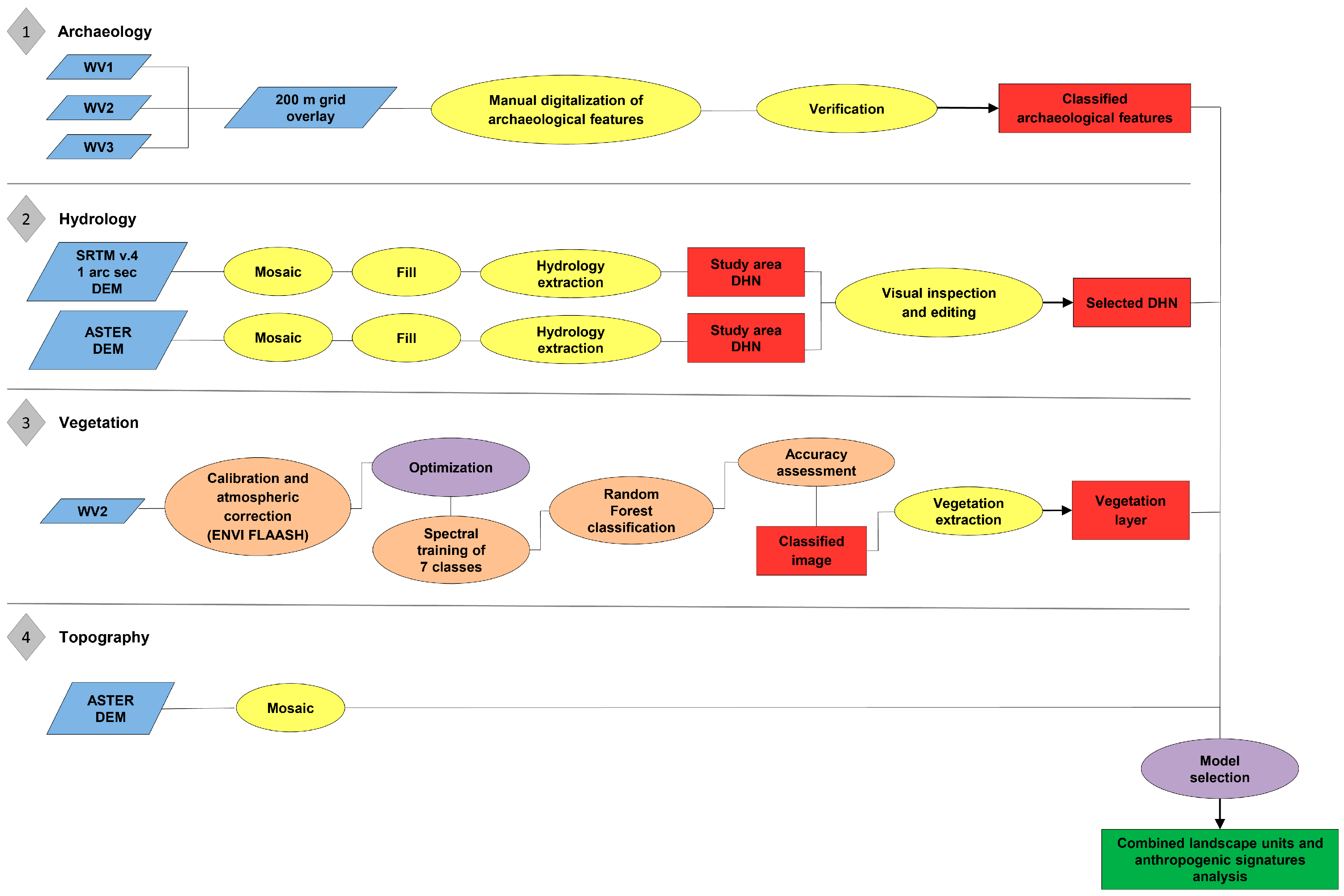
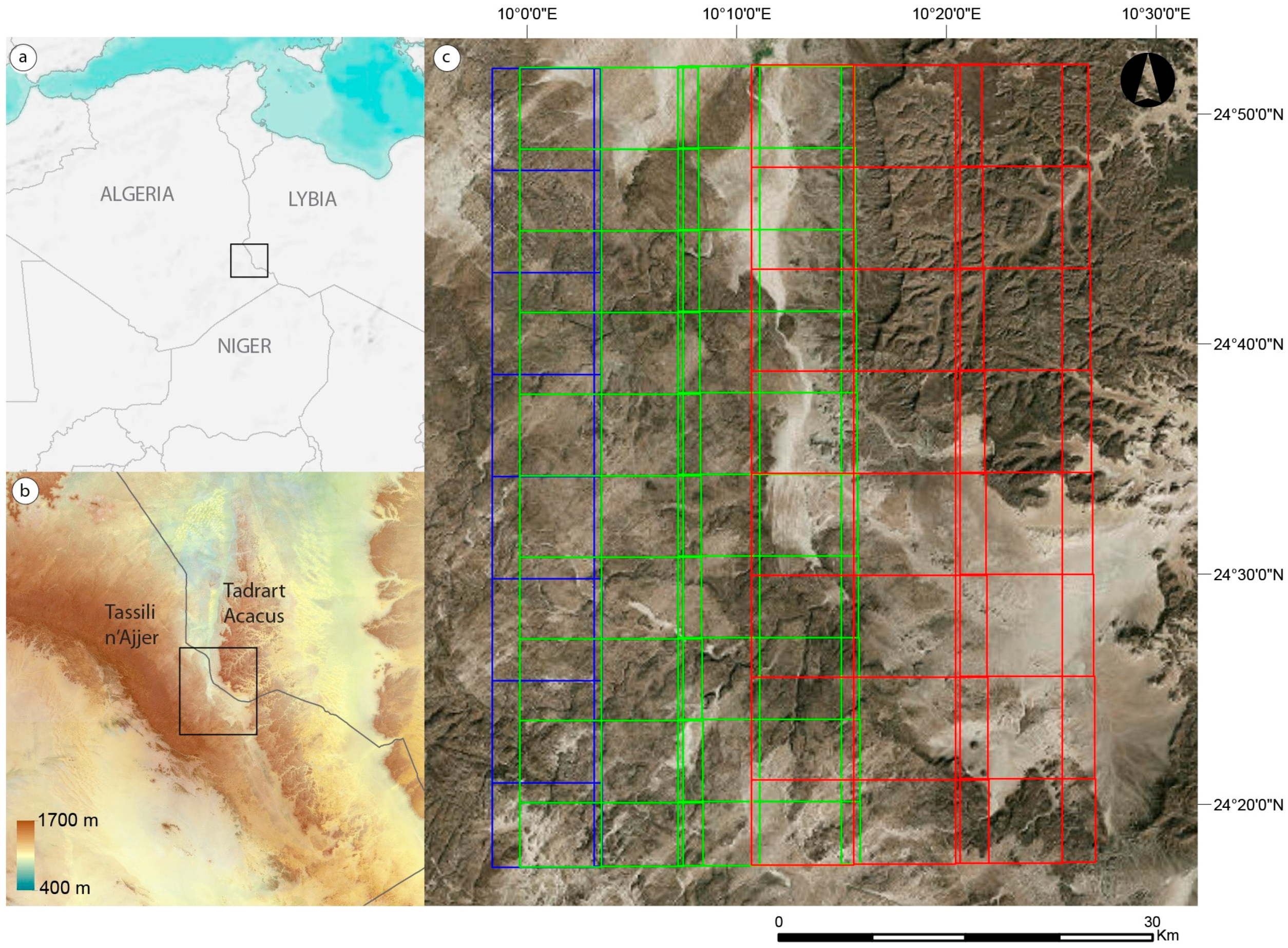
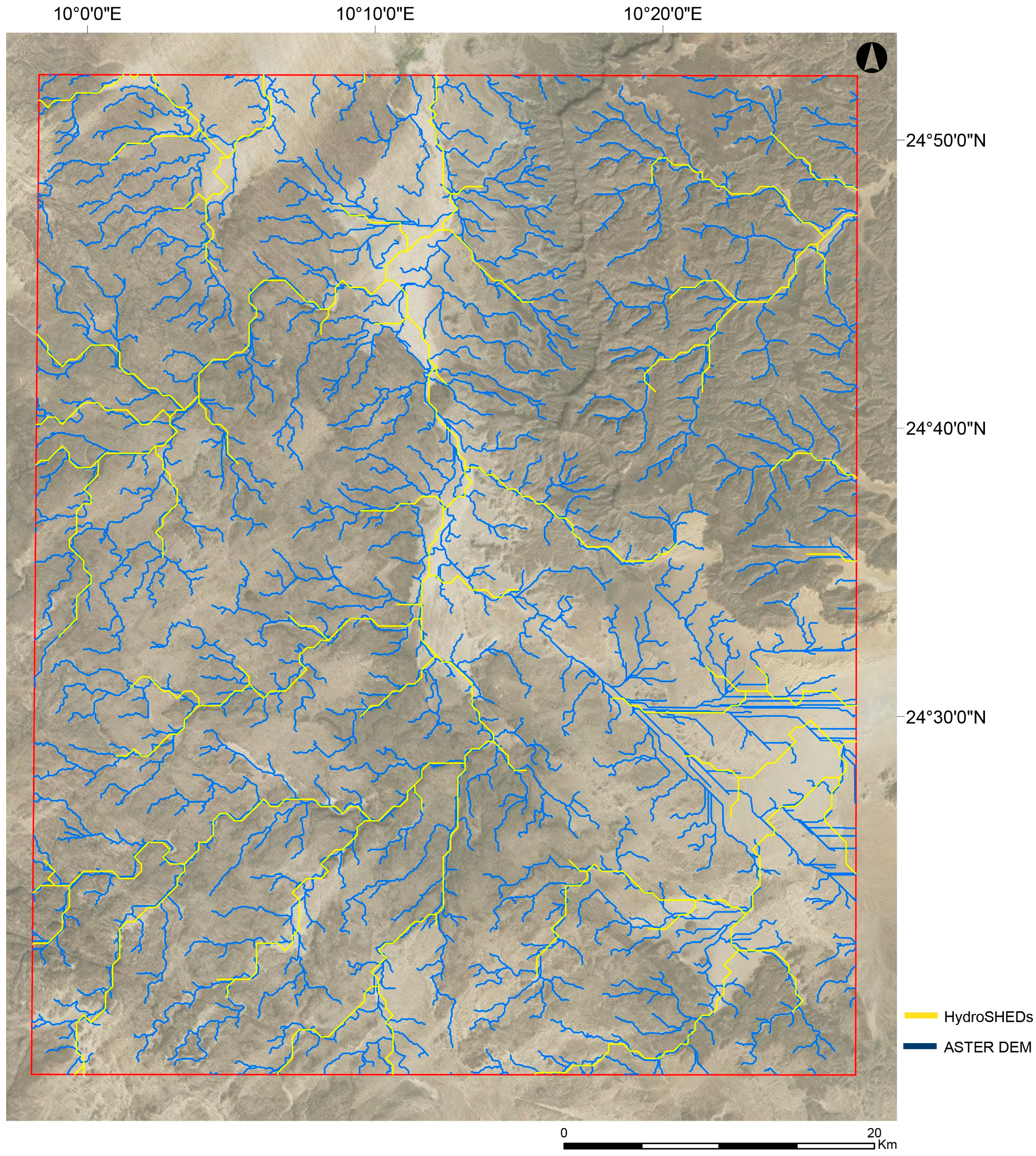
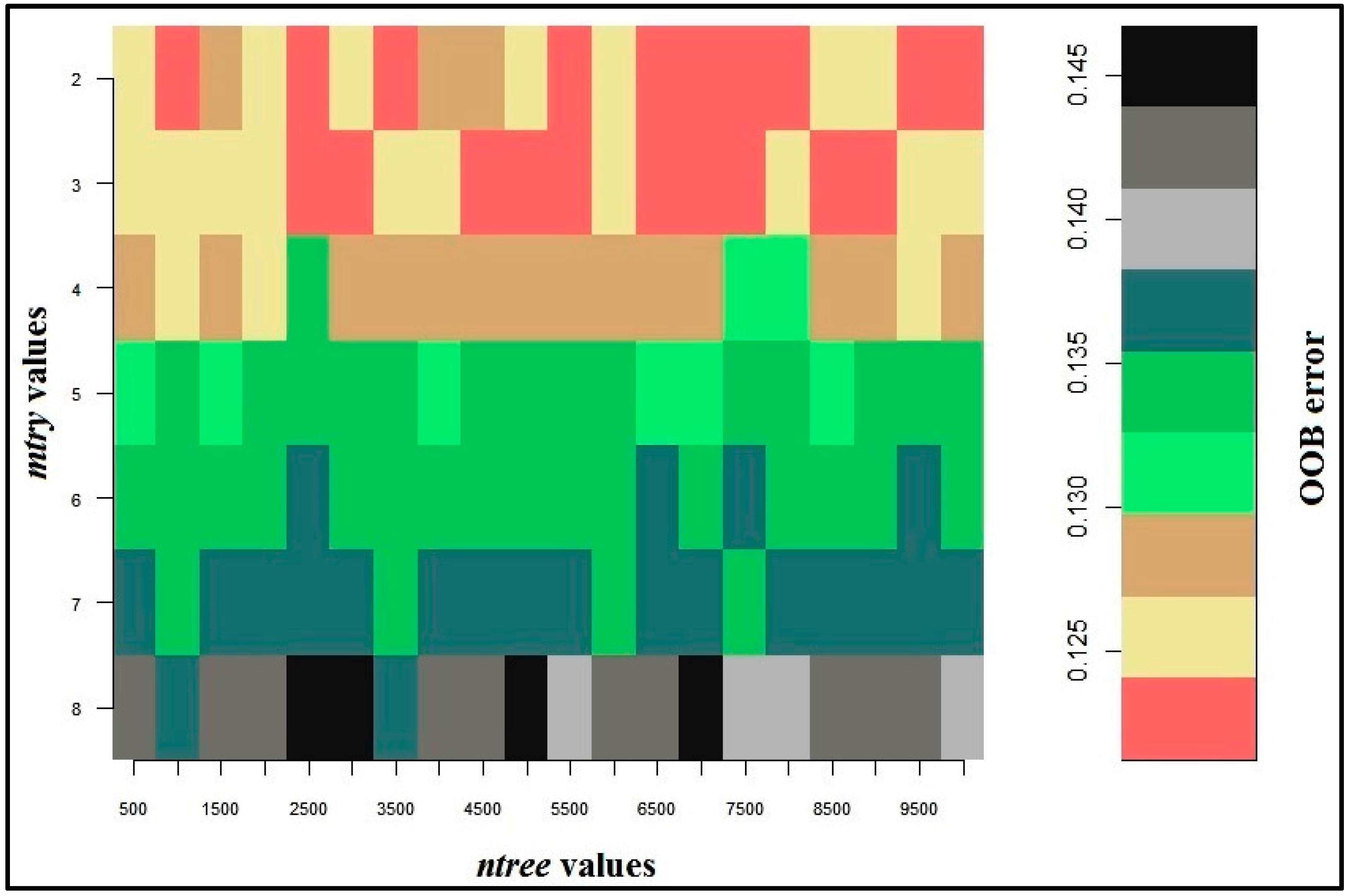




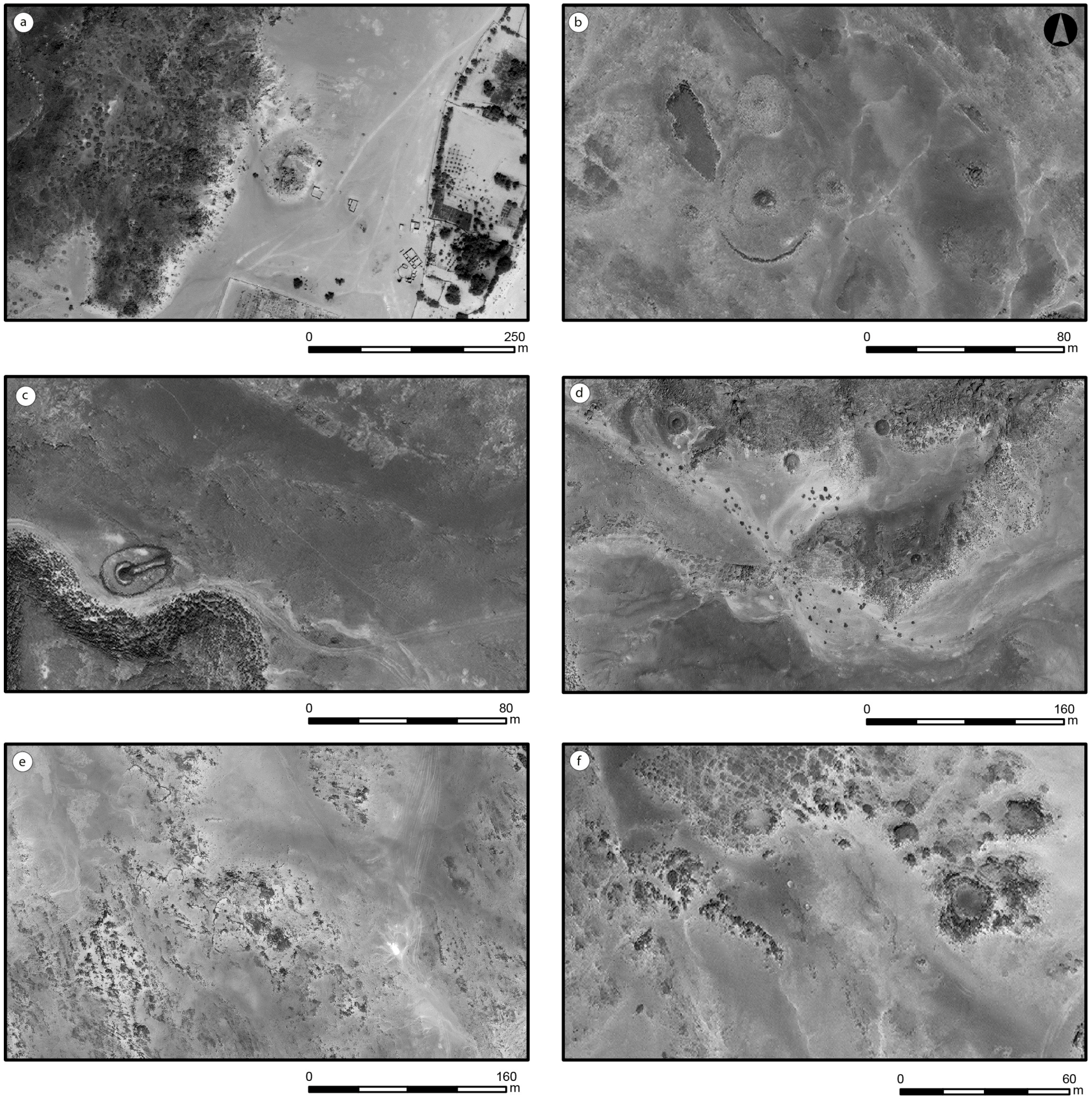
| WorldView-3 | WorldView-2 | WorldView-1 | |
|---|---|---|---|
| Date acquired | 25 October 2014 | 15 July 2013 | 9 May 2014 |
| Panchromatic spatial resolution | 31 cm | 46 cm | 50 cm |
| Swath Width at Nadir | 13.2 km | 16.4 km | 17.6 km |
| Average Revisit Time | 1 day | 1.1 days | 1.7 days |
| Spectral Bands | Pan + 8MS + 8 SWIR + CAVIS | Pan + 8MS | Pan |
| Accuracy | 3.5 m CE90 | 3.5 m CE90 | 4 m CE90 |
| Land Cover Class | Code | Training Dataset | Validation Dataset | Total |
|---|---|---|---|---|
| Woody vegetation (mainly Acacia trees) | WV | 104 | 45 | 149 |
| Shrub | SH | 104 | 44 | 148 |
| Crops | CR | 70 | 30 | 100 |
| Water body | WB | 69 | 30 | 99 |
| Sand dune | SD | 104 | 45 | 149 |
| Rock | RK | 104 | 45 | 149 |
| Shadow | SW | 102 | 44 | 146 |
| Streams Count | Total Stream Length (km) | |
|---|---|---|
| ASTER (1000 cells stream network) | 2139 | 2804.330 |
| SRTM (1000 cells stream network) | 1990 | 2742.050 |
| HydroSHEDS (SRTM derived digital hydrological network) | 106 | 670.108 |
| WV | CR | RK | SD | SH | SW | WB | Total | UA | |
|---|---|---|---|---|---|---|---|---|---|
| WV | 35 | 3 | 0 | 0 | 8 | 0 | 0 | 46 | 76.08 |
| CR | 4 | 23 | 0 | 0 | 1 | 0 | 0 | 28 | 82.14 |
| RK | 1 | 0 | 40 | 1 | 0 | 0 | 0 | 42 | 95.24 |
| SD | 0 | 0 | 3 | 40 | 9 | 0 | 0 | 52 | 76.92 |
| SH | 3 | 4 | 1 | 3 | 26 | 0 | 0 | 37 | 70.27 |
| SW | 1 | 0 | 0 | 0 | 0 | 38 | 3 | 42 | 90.48 |
| WB | 0 | 0 | 0 | 0 | 0 | 5 | 26 | 31 | 83.87 |
| Total | 44 | 30 | 44 | 44 | 44 | 43 | 29 | 278 | |
| PA | 79.55 | 76.67 | 90.91 | 90.91 | 59.09 | 88.37 | 89.66 | ||
| OA | 82.01% | ||||||||
| Kappa | 0.789 |
| Approx. Chronology | N | |
|---|---|---|
| Complex Graves | Late/Final Pastoral (c. 3000–1000BC) | |
| Antenna | 9 | |
| Crater | 13 | |
| Crater on platform | 2 | |
| Crescent | 7 | |
| Flat tumulus | 9 | |
| Keyhole | 44 | |
| Platform | 212 | |
| Stone ring | 2 | |
| Tumulus | 43 | |
| Tumulus on platform | 190 | |
| Tumulus with enclosure | 1 | |
| Total complex graves | 532 | |
| Simple Graves | Mostly historical (1000BC-AD700 ) | 5261 |
| Ksur/Compounds | Historical to Islamic | 6 |
| Enclosures | Late/Final Pastoral | 55 |
| Stone Alignments | ? | 7 |
| Contemporary Settlements | 534 | |
| Uncertain | 633 |
| AIC | Δ AIC | w | Pseudo-R2 | |
|---|---|---|---|---|
| Drainage × Vegetation × DEM | 75,583.03 | 0 | 1 | 0.2473 |
| Drainage + Vegetation + DEM | 76,039.08 | 456.05 | <0.0001 | 0.2303 |
| DEM | 77,814.92 | 2231.89 | <0.0001 | 0.1652 |
| Drainage | 81,963.86 | 6380.83 | <0.0001 | 0.0135 |
| Vegetation | 82,280.59 | 6697.56 | <0.0001 | 0.0019 |
| Intercept only | 82,329.67 | 6746.64 | <0.0001 | NA |
© 2017 by the authors. Licensee MDPI, Basel, Switzerland. This article is an open access article distributed under the terms and conditions of the Creative Commons Attribution (CC BY) license (http://creativecommons.org/licenses/by/4.0/).
Share and Cite
Biagetti, S.; Merlo, S.; Adam, E.; Lobo, A.; Conesa, F.C.; Knight, J.; Bekrani, H.; Crema, E.R.; Alcaina-Mateos, J.; Madella, M. High and Medium Resolution Satellite Imagery to Evaluate Late Holocene Human–Environment Interactions in Arid Lands: A Case Study from the Central Sahara. Remote Sens. 2017, 9, 351. https://doi.org/10.3390/rs9040351
Biagetti S, Merlo S, Adam E, Lobo A, Conesa FC, Knight J, Bekrani H, Crema ER, Alcaina-Mateos J, Madella M. High and Medium Resolution Satellite Imagery to Evaluate Late Holocene Human–Environment Interactions in Arid Lands: A Case Study from the Central Sahara. Remote Sensing. 2017; 9(4):351. https://doi.org/10.3390/rs9040351
Chicago/Turabian StyleBiagetti, Stefano, Stefania Merlo, Elhadi Adam, Augustin Lobo, Francesc C. Conesa, Jasper Knight, Hayette Bekrani, Enrico R. Crema, Jonas Alcaina-Mateos, and Marco Madella. 2017. "High and Medium Resolution Satellite Imagery to Evaluate Late Holocene Human–Environment Interactions in Arid Lands: A Case Study from the Central Sahara" Remote Sensing 9, no. 4: 351. https://doi.org/10.3390/rs9040351
APA StyleBiagetti, S., Merlo, S., Adam, E., Lobo, A., Conesa, F. C., Knight, J., Bekrani, H., Crema, E. R., Alcaina-Mateos, J., & Madella, M. (2017). High and Medium Resolution Satellite Imagery to Evaluate Late Holocene Human–Environment Interactions in Arid Lands: A Case Study from the Central Sahara. Remote Sensing, 9(4), 351. https://doi.org/10.3390/rs9040351






